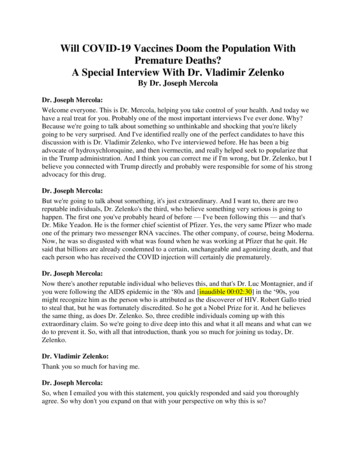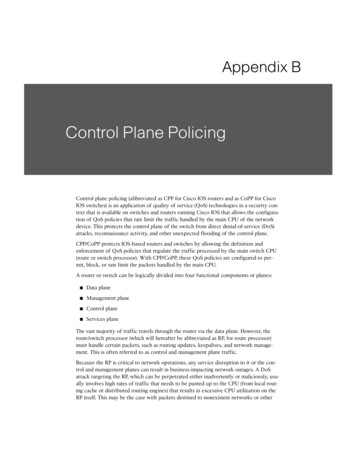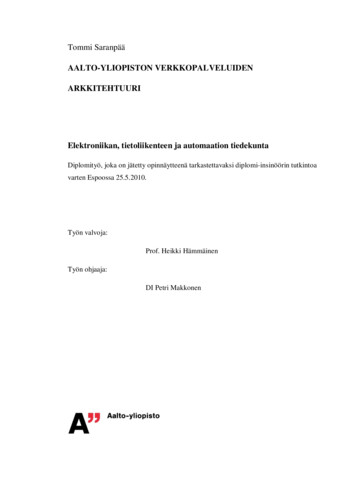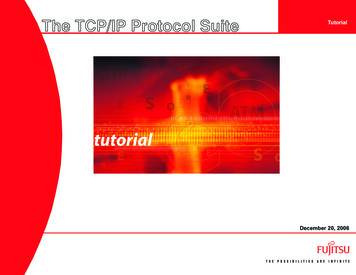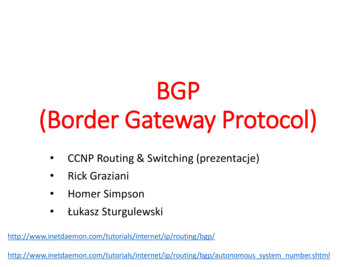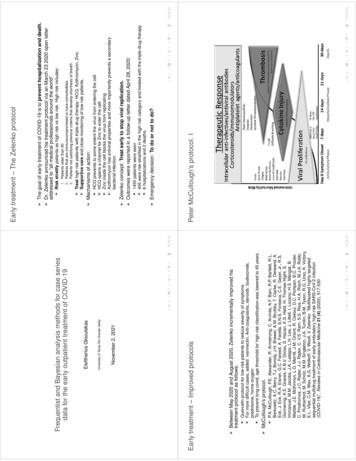
Transcription
Quercetin protocol for low-risk patients to reduce severity of symptoms.For more difficult cases, added: ivermectin, Anti-coagulants, steroids: budesonide,prednisone, home oxygen.To prevent long covid, age threshold for high-risk classification was lowered to 45 years. P.A. McCullough, P.E. Alexander, R. Armstrong, C. Arvinte, A.F. Bain, R.P. Bartlett, R.L.Berkowitz, A.C. Berry, T.J. Borody, J.H. Brewer, A.M. Brufsky, T. Clarke, R. Derwand, A.Eck, J. Eck, R.A. Eisner, G.C. Fareed, A. Farella, S.N.S. Fonseca, C.E. Geyer, Jr., R.S.Gonnering, K.E. Graves, K.B.V. Gross, S. Hazan, K.S. Held, H. Thomas Hight, S.Immanuel, M.M. Jacobs, J.A. Ladapo, L.H. Lee, J. Littell, I. Lozano, H.S. Mangat, B.Marble, J.E. McKinnon, L.D. Merritt, J.M. Orient, R. Oskoui, D.C. Pompan, B.C. Procter,C. Prodromos, J.C. Rajter, J-J. Rajter, C. V.S. Ram, S.S. Rios, H.A. Risch, M.J.A. Robb,M. Rutherford, M. Scholz, M.M. Singleton, J.A. Tumlin, B.M. Tyson, R.G. Urso, K. Victory,E.L. Vliet, C.M. Wax, A.G. Wolkoff, V. Wooll, V. Zelenko. ”Multifaceted highly targetedsequential multidrug treatment of early ambulatory high-risk SARS-CoV-2 infection(COVID-19)”, Reviews in Cardiovascular Medicine 21 (4) (2020), 517-530McCullough’s protocol. Between May 2020 and August 2020, Zelenko incrementally improved histreatment protocol as follows:Early treatment – Improved protocolsNovember 2, 2021University of Texas Rio Grande ValleyEleftherios GkioulekasFrequentist and Bayesian analysis methods for case seriesdata for the early outpatient treatment of COVID-19Treat high risk patients with triple drug therapy: HCQ, Azithromycin, Zinc.Supportive care and close monitoring of low risk patients.1. Patients older than 602. Patients that are immunocompromised or have comorbidities3. Patients not satisfying previous criteria that develop shortness of breathRisk stratify patients as high risk vs low risk. High risk includes:HCQ prevents to some extent the virus from entering the cellHCQ opens a channel for Zinc to enter the cellZinc inside the cell blocks the virus from replicatingAzithromycin has antiviral properties and more importantly prevents a secondarybacterial infection.1450 patients were seen405 were risk-stratified in the high risk category and treated with the triple-drug therapy6 hospitalizations and 2 deaths.Emergency decision: To do or not to do? Zelenko concept: Treat early to stop viral replication.Outcomes were reported in a follow-up letter dated April 28, 2020: Mechanisms of action: The goal of early treatment of COVID-19 is to prevent hospitalization and death.Dr. Zelenko announced his treatment protocol via an March 23 2020 open letteraddressed to ”all medical professionals around the world”.Peter McCullough’s protocol. I Early treatment – The Zelenko protocol
Published in March 30, 2020. CFR based on data from China as of February 11, 2020.From Table 1, the crude case fatality rates in the absence of early treatment 6930985833.6%70-7931239187.96% 80208140814.8% 60829139095.96%R. Verity and L.C. Okell and I. Dorigatti and P. Winskill and C. Whittaker and N. Imai and G.Cuomo-Dannenburg and H. Thompson and P.G.T. Walker and H. Fu and A. Dighe and J.T.Griffin and M. Baguelin and S. Bhatia and A. Boonyasiri and A. Cori and Z. Cucunuba and R.FitzJohn and K. Gaythorpe and W. Green and A. Hamlet and W. Hinsley and D. Laydon and G.Nedjati-Gilani and S. Riley and S. van Elsland and E. Volz and H. Wang and Y. Wang and X. Xiand C.A. Donnelly and A.C. Ghani and N.M. Ferguson. Lancet Infect Dis 20 (2020), 669-677Mortality risk without early treatment by age bracket. IPeter McCullough’s protocol. IIR. Verity and L.C. Okell and I. Dorigatti and P. Winskill and C. Whittaker and N. Imai andG. Cuomo-Dannenburg and H. Thompson and P.G.T. Walker and H. Fu and A. Digheand J.T. Griffin and M. Baguelin and S. Bhatia and A. Boonyasiri and A. Cori and Z.Cucunuba and R. FitzJohn and K. Gaythorpe and W. Green and A. Hamlet and W.Hinsley and D. Laydon and G. Nedjati-Gilani and S. Riley and S. van Elsland and E. Volzand H. Wang and Y. Wang and X. Xi and C.A. Donnelly and A.C. Ghani and N.M.Ferguson. Lancet Infect Dis 20 (2020), 669-677M. Scholz, R. Derwand, V. Zelenko. International Journal of Antimicrobial Agents 56(2020), 106214L. Jehi, X. Ji, A. Milinovich, S. Erzurum, A. Merlino, S. Gordon, J.B. Young, M.W. Kattan.PLoS ONE 15(8) (2020), e0237419.H. Dashti, E.C. Roche, D.W. Bates, S. Mora, and O. Demler. Scientific Reports 11(2021), 4945Without early treatment: 10%-25% risk of hospitalization for low high risk demographic. MGB study – 27% hospitalization rate Cleveland study – 26% hospitalization rate DSZ study – 15.4% hospitalization rate Early estimate of 10% to 18% hospitalization risk for patients older than 60 Published on March 23, 2020. Data as of March 17, 2020.The mortality rates in the absence of early treatment in Italy, as a function of agebracket, are consistent with the mortality rates in ChinaAgeItaly CFRChina 0.4%0.4%50-591.0%1.3%60-693.5%3.6%70-7912.8%8.0% 8020.2%14.8%Without early treatment: Mortality rate risk for high-risk demographic due to ageranges from 3.5% to 20%. Graziano Onder, Giovanni Rezza, Silvio Brusaferro. JAMA 323 (2020), 1775-1776Mortality risk without early treatment by age bracket. II Hospitalization risk without early treatment
Deaths9280321616Cases87311025112683107China 361744264Israel CFR16.7%13%6%13.7%10%Without early treatment: Mortality rate risk for high-risk demographic due to comorbiditiesranges from 5% to 15%.Scholz, M.; Derwand, R.; Zelenko, V. International Journal of Antimicrobial Agents 56(2020), 106214H.A. Risch. American Journal of Epidemiology 189 (2020), 1218-1226H.A. Risch. American Journal of Epidemiology 189 (2020), 1444-1449N. Barda, D. Riesel, A. Akriv, J. Levy, U. Finkel, G. Yona, D. Greenfeld, S. Sheiba, J.Somer, E. Bachmat, G.N. Rothblum, U. Shalit, D. Netzer, R. Balicer, Noa Dagan. NatureCommunications 11 (2020), 4439B.C. Procter, C. Ross, V. Pickard, E. Smith, C. Hanson, P.A. McCullough. Reviews inCardiovascular Medicine 21 (4) (2020), 611-614B.C. Procter, C. Ross, V. Pickard, E. Smith, C. Hanson, P.A. McCullough. InternationalJournal of Innovative Research in Medical Science 6 (2021), 219-221 M. Million, J-C. Lagier, H. Tissot-DuPont, I. Ravaux, C. Dhiver, C. Tomei, N Cassir, L.DeLorme, S. Cortaredona, S. Gentile, E. Jouve, A. Giraud-Gatineau, H. Chaudet, L.Camoin-Jau, P. Colson, P. Gautret, P-E. Fournier, B. Maille, J-C. Deharo, P. Habert, J-Y.Gaubert, A. Jacquier, S. Honore, K. Guillon-Lorvellec, Y. Obadia, P. Parola, P. Brouqui,D. Raoult, Reviews in Cardiovascular Medicine 22 (2021), 1063-1072Raoult case series – 1495 high risk patients – McCullough protocol Procter second case series – 869 high risk patients – McCullough protocol Procter first case series – 320 high risk patients – McCullough protocol Israeli control group – 4179 low and high risk patients – no early treatment Zelenko 06-14-2020 case series – 800 high risk patients – enhanced Zelenko protocol Zelenko 04-28-2020 case series – 405 high risk patients – Zelenko protocol DSZ study – 141 high risk patients – lab confirmed only – Zelenko protocolCase series evidence ComorbidityCardiovascular diseaseDiabetesRespiratory diseaseHypertensionCancerCase fatality rate based on early-stage analysis of COVID-19 outbreak in China in theperiod up to February 11, 2020 vs similar statistics from Israel published on September7, 2020.Epidemiology Group of Emergency Response Mechanism of New Coronavirus Pneumonia,Chinese Center for Disease Control and Prevention. Chinese Journal of Epidemiology 41(2020), 145-151. N. Barda, D. Riesel, A. Akriv, J. Levy, U. Finkel, G. Yona, D. Greenfeld, S. Sheiba, J. Somer, E.Bachmat, G.N. Rothblum, U. Shalit, D. Netzer, R. Balicer, Noa Dagan. NatureCommunications 11 (2020), 4439 Mortality risk without early treatment from comorbiditiesMultivariate regression analysis for risk factors has calculated the followingodds-ratios:ComorbidityOdds Ratio p-valueHeart disease 1.67 (1.03–2.70)0.037Dyspnea at diagnosis2.07 (1.33-3.26)0.0017Obesity 2.38 (1.24–4.58)0.009Comparison of these 3 risk factors shows that both obesity and dyspnea are moredangerous than heart disease. In the US, doctors tried to prevent hospitalizations due to poor NIH standard ofcare.Raoult control group did not receive the complete protocol (duration, medications). Raoult encouraged short hospitalization in his institution for close monitoring Consistent mortality rates between Zelenko control group (without demographicdata) and Israeli control group (with demographic data; low high risk)Hospitalizations & Deaths4 (2.8%)1 (0.7%)6 (1.4%)2 (0.4%)12 (1.5%)2 (0.25%)6 (1.8%)1 (0.3%)20 (2.3%)2 (0.2%)106 (7.0%)5 (0.3%)58 ( 15%)13 ( 3.4%)N/A143 ( 3.4%)38 (7.3%)11 (2%)Consistent high-risk mortality rates between Zelenko, Procter, and RaoultHigh-risk1414058003208691495 377 4179520 Total71214502200922?1042937741792114 StudyDSZ studyZelenko April 2020Zelenko June 2020Procter IProcter IIRaoultDSZ controlIsraeli controlRaoult controlSummary of high risk patient case seriesWithout early treatment: Mortality rate risk due to obesity and dyspnea 5%.S.N.S. Fonseca, A. de Queiroz Sousa, A.G. Wolkoff, M.S. Moreira, B.C. Pinto,C.F.V. Takeda, E. Rebouas, A.P.V. Abdon, A.L.A. Nascimento, H.A. Risch. TravelMedicine and Infectious Disease 38 (2020), 101906 Previous papers do not provide a mortality rate risk due to obesity and shortnessof breath. Mortality risk without early treatment from obesity and shortness ofbreath
Consistency between control groups.We are expecting more than 90% efficacy in mortality and hospitalization ratereduction against no early treatment.Question: What if we want to determine that the treatment is effective againstno treatment without measuring the precise efficacy? n 0p(N, n x)H(p(N, a x) p(N, n x))(6)(5)To establish statistical significance, we seek a threshold x0 such thatx0 x 1 P(N, a, x) p0 , and then we show that x x0 .Standard choice is to use p0 0.05 for 95% confidence. Alternatively, we can alsoexplore the x0 thresholds for p0 0.01 (99% confidence) and p0 0.001 (99.9%confidence), to see how sensitive x0 is to increasing demands in statistical confidence.with p(N, a x) the probability of the specific outcome (N, a) given by N aN ap(N, a x) x (1 x)aP(N, a, x) N Let N be the number of treated patients, a the number of treated patients with anadverse outcome (hospitalization or death).Let x be the probably of adverse outcome if the patient is untreated.We assume that the treatment itself is safe and causes no adverse events.We wish to reject the null hypothesis that the treatment is ineffective and that the event(N, a) just happened by chance.The p-value for rejecting the null hypothesis, as a function of x, is given byWe can compare case series with known hospitalization/mortality rates foruntreated high-risk patients, as follows:Methodology: Analysis of case seriesDemographic data available for Israeli control group: low high risk0.0210 1310 190.05–0.450.03–0.190.04–0.16No demographic data for Zelenko control group0.120.00310 50.090.000210 ��0.570.02–0.28 p-value95% CI Studyodds ratioExact Fisher tests on mortality ratesDSZ study vs DSZ control0.2Zelenko April 2020 vs DSZ control0.13Zelenko June 2020 vs DSZ control0.07DSZ vs Israeli control0.2Zelenko April 2020 vs Israeli control0.14Zelenko June 2020 vs Israeli control 0.07Exact Fisher tests on hospitalization ratesDSZ vs DSZ control0.16Zelenko April 2020 vs DSZ control0.08Zelenko June 2020 vs DSZ control0.08Zelenko case series vs control groupsn 0 ,1.2.3.4.C. Clopper and E.S. Pearson. Biometrika 26 (1934), 404-413T.E. Sterne. Biometrika 41 (1954), 275-278J. Reiczigel. Statistics in Medicine 22 (2003), 611-621L.D. Brown, T.T. Cai, A. DasGupta. Statististical Science 16 (2) (2001), 101-133Binomial proportion confidence interval problem.For the math background see: With the Clopper-Pearson interval the right tail of the distribution is assumed to beequal to the left tail. Thus, equivalent to a one-tail test.An alternate approximation of x0 can be obtained using the upper endpoint of theClopper-Pearson interval: x0 (N, a, p0 ) inf{x [a/N, 1] an 0 p(N, n x) p0 /2}(8)The threshold corresponds to the upper endpoint of the Sterne interval. (7)(4)(3)with p0 0.05 for 95% confidence, p0 0.01 for 99% confidence and p0 0.001for 99.9% confidence.x0 (N, a, p0 ) inf{x [a/N, 1] P(N, a, x) p0 }By definition, we calculate the efficacy threshold x0 via the equationMethodology: Calculating the efficacy threshold (2)(1)p(N, n, M, a b n)H(p(N, a, M, b) p(N, n, M, a b n)),N a N M Nmin{N,a b}bwith H(x) being a modified Heavyside function given by 1,if x 0H(x) 0,if x 0.P(N, a, M, b) p(N, a, M, b) and the corresponding p-value is given by a b N M a b a(M b),b(N a)The odds ratio comparing the two groups is given by OR Let N be the number of treated patients, a the number of treated patients with an adverseoutcome (hospitalization or death), M the number of untreated patients in the control group,and b the number of untreated patients with an adverse outcome (hospitalization or death) inthe control group. Methodology: Exact Fisher test
Smooth curve is the Clopper-Pearson interval approximate efficacy threshold US CFR ranged from 2% to 6% in 2020 and converged to 1.7% in 2021France CFR ranged from 2% to 16% in 2020 and also converged to 1.7% in 2021CFR exceeds efficacy thresholds for Zelenko June 2020, Procter II, Raoult!! Note the dependence on p2 (i.e. maximum risk of adverse outcome withouttreatment)We want b(x0 , p2 ) 2 (decisive), or at least b(x0 , p2 ) 1.5 (very strong)t (0,x0 )b(x0 , p2 ) max log B(N, a H1 (t), H0 (x0 , p2 ))We assess the efficacy threshold x0 by calculatingp(N, a H0 (p1 , p2 )) N p21x a (1 x)N a dxp2 p1 ap1 1 N q ap(N, a H1 (q)) x (1 x)N a dxq a0p(N, a H1 (q))B(N, a H1 (q), H0 (p1 , p2 )) p(N, a H0 (p1 , p2 ))The Bayesian factor is given byWe introduce the null hypothesis H0 (p1 , p2 ) : p1 x p2 and the efficacyhypothesis H1 (q) : x q.Calculates “distance” between efficacy and null hypothesis at the efficacythreshold x0 .Bayesian factor analysis(12)(11)(10)(9)Risk intervals without early treatment exceed efficacy thresholds above (except forDSZ study wrt mortality risk reduction)Without early treatment: 3.5%–20% mortality risk Without early treatment: 10%–25% hospitalization risk 10.6% (10.7%)4.7%3.5%5.9%4.5%8.8% (8.7%)3.9%3.0%4.9%4%These are all case series with high-risk patientsN/A3%1.6% (1.5%)3.1%1.4% (1.38%)1.16%5.4% (5.2%)2.5% (2.3%)1.3% (1.2%)2.3%1.08% (1.07%)0.96% (0.95%) 99.9% threshold99% threshold Study95% thresholdMortality rate efficacy thresholdsDSZ study3.8% (3.9%)Zelenko April 20201.8%Zelenko June 20201.0%Procter I1.7% (1.8%)Procter II0.84% (0.83%)Raoult0.79% (0.78%)Hospitalization rate efficacy thresholdsDSZ study7.0% (7.2%)Zelenko April 20203.2%Zelenko June 20202.7%Procter I4.1%Procter II3.6%Efficacy thresholds for mortality and hospitalization rates Compare with Case Fatality Rate in US and FranceZigzag curve is the exact Sterne interval efficacy threshold Example: Proctor II case series (expected mortality without earlytreatment vs p-value)
Other studies look ok. An RCT can measure the efficacy if both arms of the trial are sufficiently large.However, the decision to deploy early treatment is Boolean: yes or noEnough evidence to authorize early treatment was available by April 29, 2020.Early treatment has been and still is suppressed by public health officials. 1. R.B. Stricker and M.C. Fesler. Journal of Infection and Public Health 14 (2021),1161-11632. P. Behera, B.K. Patro, B.M. Padhy, P.R. Mohapatra, S.K. Bal, P.D. Chandanshive, R.R.Mohanty, SR Ravikumar, A. Singh, S.R. Singh, S.S.K. Pentapati, J. Nair, G.Batmanbane. Cureus 13(8) (2021), e16897.Prophylactic protocols:1. S.J. Hatfill. Journal of the American Physicians and Surgeons 26 (2021), 74-762. L. Mucchielli. Journal of Sociology 56 (2020), 736-744This approach proves existence of efficacy but does not precisely calculateefficacy. We presented the mathematical techniques for doing so. it is possible to establish efficacy by comparing case series of high risk patientsagainst previously observed mortality/hospitalization risks without treatment.1. Signal of benefit for early treatment is very strong;2. Early treatment uses repurposed drugs with known excellent safety record;3. The alternative is to do nothing;Because: Concluding thoughtsWith DSZ study, we are cautioned due to small sample size the efficacythresholds may need to be increased.20% Bayes1.922.392.612.322.3910% Bayes1.992.453.022.472.822.79 Bayes factors at the mortality rate efficacy thresholdsStudy95% threshold 2% Bayes5% BayesDSZ study3.8%N/A1.38Zelenko April 20201.8%1.172.04Zelenko June 2020 1.0%2.062.66Procter I1.7%1.282.07Procter II0.84%1.922.48Raoult0.79%1.912.45Bayes factors at the hospitalization rate efficacy thresholdsStudy95% threshold 10% Bayes 15% BayesDSZ study7.0%1.301.71Zelenko April 20203.2%2.002.24Zelenko June 2020 2.7%2.242.47Procter I4.1%1.892.15Procter II3.6%1.982.23Bayes factor at efficacy thresholds p2 20%7.2%2.9%2.4%3.7%3.4%p2 10%3.9%1.5%0.6%1.3%0.6% 0.7%Thank you!All Bayes efficacy thresholds are also below what is necessary to establish inhospitalization and mortality rate reduction.Mortality rate Bayesian efficacy thresholdsStudy95%log Bayes 2 thresholdsthresholdp2 2%p2 5%DSZ study3.8%N/AN/AZelenko April 20201.8%N/A1.8%Zelenko June 20201.0%1.0%0.8%Procter I1.7%N/A1.9%Procter II0.84%0.87%0.7%Raoult0.79%0.82% 0.7%Hospitalization rate Bayesian efficacy thresholdsStudy95%log Bayes 2 thresholdsthresholdp2 10% p2 15%DSZ study7.0%9.5%7.8%Zelenko April 20203.2%3.2%3.0%Zelenko June 20202.7%2.6%2.5%Procter I4.1%4.3%4.0%Procter II3.6%3.7%3.5%Bayes corrected thresholds
Early treatment - The Zelenko protocol The goal of early treatment of COVID-19 is to prevent hospitalization and death. Dr. Zelenko announced his treatment protocol via an March 23 2020 open letter addressed to "all medical professionals around the world". Risk stratify patients as high risk vs low risk. High risk includes: 1. Patients .


